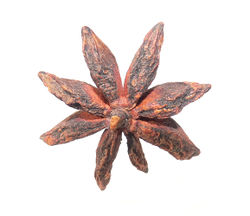Illicium verum
| Star anise | |
|---|---|
 |
|
| Star anise fruits (Illicium verum) | |
| Scientific classification | |
| Kingdom: | Plantae |
| Division: | Magnoliophyta |
| Class: | Magnoliopsida |
| Order: | Austrobaileyales |
| Family: | Illiciaceae |
| Genus: | Illicium |
| Species: | I. verum |
| Binomial name | |
| Illicium verum Hook.f. |
|

Star anise, star aniseed, or Chinese star anise, (Chinese: 八角, pinyin: bājiǎo, lit. "eight-horn") is a spice that closely resembles anise in flavor, obtained from the star-shaped pericarp of Illicium verum, a small native evergreen tree of southwest China. The star shaped fruits are harvested just before ripening.
Contents |
Nomenclature and taxonomy
In Persian, star anise is called badian, whence its French name badiane. In northern India it is called badian khatai. It is said that its origin is a place called Khata in China.
List of the cultivars
Usages
Culinary uses
Star anise contains anethole, the same ingredient which gives the unrelated anise its flavor. Recently, star anise has come into use in the West as a less expensive substitute for anise in baking as well as in liquor production, most distinctively in the production of the liquor Galliano. It is also used in the production of sambuca, pastis, and many types of absinthe. Star anise enhances the flavour of meat. It is used as a spice in preparation of biryani all over the Indian subcontinent. It is widely used in Chinese cuisine, in Indian cuisine where it is a major component of garam masala, and in Malay and Indonesian cuisine. It is widely grown for commercial use in China, India, and most other countries in Asia. Star anise is an ingredient of the traditional five-spice powder of Chinese cooking. It is also a major ingredient in the making of phở, a Vietnamese noodle soup. In India it is used as an ingredient of masala chai.
Medicinal uses
Star anise has been used in a tea as a remedy for rheumatism, and the seeds are sometimes chewed after meals to aid digestion. As a warm and moving herb, star anise is used to assist in relieving cold-stagnation in the middle jiao, according to Traditional Chinese medicine.
Shikimic acid, a primary feedstock used to create the anti-influenza drug Tamiflu, is produced by most autotrophic organisms, but star anise is the industrial source. In 2005, there was a temporary shortage of star anise due to its use in making Tamiflu. Late in that year, a way was found of making shikimic acid artificially. Roche now derives some of the raw material it needs from fermenting E. coli bacteria. The 2009 swine flu outbreak led to another series of shortages as stocks of Tamiflu were built up around the world, sending prices soaring.[1]
Star anise is grown in four provinces in China and harvested between March and May. Its also found in the south of New South Wales. The shikimic acid is extracted from the seeds in a ten-stage manufacturing process which takes a year. Reports say 90% of the harvest is already used by the Swiss pharmaceutical manufacturer Roche in making Tamiflu, but other reports say there is an abundance of the spice in the main regions - Fujian, Guangdong, Guangxi and Yunnan.
Japanese star anise (Illicium anisatum), a similar tree, is not edible because it is highly toxic (due to containing sikimitoxin); instead, it has been burned as incense in Japan. Cases of illness, including "serious neurological effects, such as seizures", reported after using star anise tea may be a result of using this species. Japanese star anise contains anisatin, which causes severe inflammation of the kidneys, urinary tract and digestive organs.
- Using star anise as a remedy for colic is dangerous as referenced here.
Toxicology
Standardization of its products and services
- ISO 676:1995 - contains the information about the nomenclature of the variety and cultivars[2]
Identification
- Refer to the 4th edition of the European Pharmacopoeia [1153].
Differentiation with other species
Joshi et al. have tried the techniques of fluorescent microscopy and gas chromatography[3] to distinguished the species, while Lederer et al. employed the state of the art which combines the technology of TLC with HPLC-MS/MS.[4]
Specifications
- ISO 11178:1995 - a specification for its dried fruits[5]
- GB/T 7652:2006 - a Chinese standard of the product[6]
See also
- Dysosma versipellis
- Fatsia
- Illicium
- Japanese star anise
- Pimpinella anisum
Notes and references
- ↑ Louisa Lim, "Swine Flu Bumps Up Price Of Chinese Spice", NPR, 18 May 2009
- ↑ International Organization for Standardization. "ISO 676:1995 Spices and condiments -- Botanical nomenclature". http://www.iso.org/iso/iso_catalogue/catalogue_tc/catalogue_detail.htm?csnumber=4844. Retrieved 8 June 2009.
- ↑ Joshi, Vaishali C. et al. (2005). "Rapid and Easy Identification of Illicium verum Hook. f. and Its Adulterant Illicium anisatum Linn. by Fluorescent Microscopy and Gas Chromatography". Journal of AOAC International (AOAC International) 88 (3): 703–706. doi:10.1542/peds.2004-0058. PMID 15492355. http://www.atypon-link.com/AOAC/doi/abs/10.5555/jaoi.2005.88.3.703. Retrieved 10 November 2007.
- ↑ Lederer, Ines et al. (2006). "Combination of TLC and HPLC-MS/MS Methods. Approach to a Rational Quality Control of Chinese Star Anise". Journal of Agricultural and Food Chemistry (American Chemical Society) 54 (6): 1970–1974. doi:10.1021/jf058156b.
- ↑ International Organization for Standardization. "ISO 11178:1995 Star anise (Illicium verum Hook. f.) -- Specification". http://www.iso.org/iso/catalogue_detail.htm?csnumber=19183. Retrieved 8 June 2009.
- ↑ 供销总杜南京野生植物综合利用研究院. "GB/T 7652-2006 八角". http://www.chinaios.com/BZ-shuju/standshow.asp?table=gbtwo&id=18357. Retrieved 8 June 2009.
Bibliography
External links
|
||||||||||||||||||||||||||||||||||||||||||